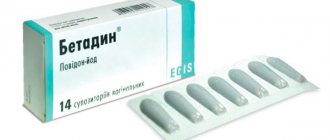Inflammatory diseases of the female reproductive system are treated with medications from different pharmacological groups. In combination with antibacterial agents in the acute period of pathologies, it is necessary to include non-steroidal anti-inflammatory drugs (NSAIDs) to relieve uncomfortable symptoms². For example, doctors prescribe the drug in the form of rectal suppositories Indomethacin.
All women who have had inflammatory processes in the appendages, endometriosis or cysts in the ovaries know for sure that the pain is very pronounced. The use of Indomethacin in suppositories significantly improves the quality of life.
Indications
Indomethacin suppositories are effective for the following gynecological diseases as an auxiliary therapy to relieve pain and inflammation.
- Algodismenorrhea. The pathology is characterized by pain during menstruation, from mild discomfort to severe pain that a woman has to endure until her first birth or menopause. Using Indomethacin suppositories is a good way to relieve a woman’s condition during menstruation.
- Endometriosis is also accompanied by pain and discomfort. Indomethacin, due to its actively expressed anti-inflammatory effect, fights this pathology.
- Cystitis. Indomethacin suppositories for cystitis are used in combination with antibiotic therapy.
- Adnexitis is an inflammatory process in the uterine appendages with pelvic pain. Indomethacin suppositories are prescribed by doctors in the complex treatment of this disease.
- Ovarian cyst and fibroma. Indomethacin suppositories have pronounced anti-inflammatory and analgesic properties in these diseases.
- Fibroids are a benign tumor in the uterus that are sensitive to the main component of the drug. With constant use of suppositories, its growth slows down.
Description of the drug and its use in gynecology
Indomethacin belongs to the group of non-steroidal anti-inflammatory drugs. It comes in the form of suppositories that can be used both rectally and vaginally. One cardboard package contains 10 suppositories, each of which contains 50-100 mg of active ingredient. The drug should be stored for 2 years at temperatures up to 25 degrees.
In gynecology, suppositories are used to relieve pain and relieve inflammation. Indomethacin can be prescribed for large ovarian cysts that cause discomfort to the patient or are accompanied by inflammation in the genitals. The medication is effectively used when body temperature rises due to gynecological and other diseases.
Indomethacin suppositories are auxiliary in the treatment of ovarian cysts and do not affect their elimination in any way.
The effectiveness of suppositories
Suppositories are prescribed for most forms of oophoritis as an additional or primary method of therapy.
For local treatment, suppositories based on antimicrobial, anti-inflammatory, enzymatic and biotic agents are used.
The effectiveness of suppositories is determined by their local effect, aimed exclusively at the pathological focus.
Compared to injections and tablets, suppositories have the following advantages:
- Candles can be used independently at home;
- Unlike injections, the use of suppositories is painless;
- Since suppositories act at the local level, they contain less medication;
- Smaller doses of the drug allow you to avoid many complications of general therapy;
- There is no toxic effect on the liver and kidneys;
- There is no risk of injury to the vein walls and injection hematoma that occur after injections;
- Suppositories have a longer lasting effect due to slow resorption.
Compared to injection and tablet forms, suppositories are more effective for severe manifestations of local inflammation:
- Discharges;
- Spasm;
- Swelling of the mucous membranes;
- Pain.
Use during lactation and pregnancy
Indomethacin suppositories are prescribed for the treatment of general and local inflammatory processes in gynecological and ENT diseases, neuralgia, protein metabolism disorders, tissue inflammation after injury, prostatitis, and diseases of the musculoskeletal system. Indomethacin-based suppositories are especially effective in the treatment of such ailments, accompanied by constant or periodic pain and high fever.
Rectal indomethacin is used for a wide range of diseases:
- gout;
- osteoporosis;
- rheumatoid arthritis;
- thrombophlebitis;
- pain in the spine;
- inflammation of bone tissue;
- Bekhterov's disease;
- periarthritis;
- myalgia;
- connective tissue inflammation;
- algodismenorrhea;
- endometriosis;
- cystitis;
- ovarian cyst;
- risk of miscarriage;
- fibroleiomyoma of the uterus;
- inflammation of the uterine appendages.
Indomethacin suppositories should be used strictly on the recommendation of the attending physician and in accordance with the treatment regimen determined by him. Exceeding the safe dose of the drug may increase the risk of side effects. The maximum number of uses is up to three times a day, suppositories of 50 mg and one of 100 mg. It is recommended to use the product at night, after doing an enema.
Indomethacin suppositories are often prescribed not only by therapists, but also by gynecologists to cure a number of inflammatory processes, both local and general.
As a primary remedy and in complex treatment, they are used to treat:
- inflammation in the bone tissues of the musculoskeletal system;
- cure gout, myalgia, thrombophlebitis;
- arthritis, rheumatism, osteoporosis;
- prostatitis, hemorrhoids in men;
- infectious diseases in ENT diseases;
- neuralgia, disorders in the body's protein metabolism.
For the treatment of women, gynecologists often prescribe rectally or vaginally.
The vaginal route is usually used to relieve the symptoms of hemorrhoids, but the method of administration is entirely dependent on the recommendations of the attending physician.
Indomethacin suppositories are often used as an effective pain reliever during menstruation or severe inflammation due to the problem of cystitis and endometriosis.
Most often, complex treatment is used to solve complex diseases, one component of which is indomethacin suppositories, and the other is an antibiotic.
As part of this combination treatment, the following symptoms can be removed:
- fibroleiomyomas of the uterus;
- ovarian brushes;
- inflammation of the appendages.
In some cases, Indomethacin suppositories help to cope with situations where there is a possibility of miscarriage.
Indomethacin is a potent anti-inflammatory drug that can cope with severe fever and pain. However, it has side effects due to the active substances.
Quite often, suppositories can cause exacerbation of existing chronic diseases, so there are a number of absolute contraindications for which people should never use the medicine.
Such diseases include:
- liver failure or cirrhosis;
- internal bleeding;
- diseases of the cardiovascular system;
- kidney diseases;
- stomach or duodenal ulcer;
- problems with the optic nerve;
- constant presence of sufficiently high pressure.
The drug should not be used during lactation and until the child reaches 14 years of age. The use of suppositories is prohibited if you have hypersensitivity or an allergic reaction to the components of the medicine.
You should treat the drug with great caution and be sure to consult a doctor if you have the following diseases:
- blood clotting disorders;
- asthma, epilepsy, Parkinson's syndrome, lupus;
- with the preliminary administration of vaccines that contain live microorganisms;
- before surgery;
- problems with the digestive system and intestines..
Indomethacin suppositories can be used only after turning 14 years old, only as prescribed by a doctor. It is he who must select the dosage and time of treatment, fully relying on the severity of the disease and its course.
However, basically the drug is used 1 suppository 1 or 2 times a day for a period not exceeding 2 weeks.
If at the end of this period no visible changes are observed, then a new consultation with the doctor is required, since the dose used may need to be adjusted or the treatment provided is not enough.
Suppositories can be administered rectally or vaginally, but the method of administration must be decided by the doctor.
The greatest effect is achieved when administered into the rectum:
- The first step is to perform a gastric lavage with a cleansing enema before introducing suppositories. This is especially true for people suffering from constant constipation;
- Before using the Indomethacin suppository, place it in cold water or in the refrigerator directly in its wrapper for about half an hour to make it firmer;
- Remove the foil wrapper from the candle and lightly moisten it with water to make insertion easier;
- To properly insert a suppository into the rectum, lie on your left side and slightly raise your right knee. For left-handers, actions should be diametrically opposed;
- Using light finger pressure, insert the suppository into the rectum about two and a half centimeters;
- Continue to lie there for a few more minutes and try to avoid going to the toilet for at least another hour to give the medication time to be absorbed into your body and begin to work.
Indomethacin should not be used if you have problems with the kidneys or liver, since the drug is metabolized in the liver and excreted by the kidneys.
If the systems are disrupted, the body is not able to remove potent substances and these harm the body.
That is why very often during treatment, the doctor simultaneously monitors the condition of the liver and kidneys, even in a person whose systems are normal due to the strong possibility of damaging them.
The medicine is prescribed very carefully, especially if the patient is over 60 years old. At this age, blood clotting disorders are observed.
Very often, Indomethacin can cause problems with the circulatory system and increase blood pressure.
In gynecology, suppositories with indomethacin are used for the following indications:
- Endometriosis and adenomyosis. Candles relieve pain and reduce inflammation.
- Ovarian cyst – slows down the growth of the tumor.
- Inflammation of the appendages – relieves pain and relieves inflammation.
- Inflammation of the ovaries, fallopian tubes - therapeutic effect.
- The likelihood of miscarriage - indomethacin suppositories are used only according to the indications of a specialist in the period from 16 to 32 weeks.
- Inflammation of the walls of the uterus - relieves pain and relieves inflammation.
- Fibroma – slows down tumor growth.
- Painful periods - relieve pain.
- Cystitis - relieve pain and inflammation, prescribed together with antibacterial drugs.
- Inflammation of the appendages – relieves pain and relieves inflammation.
- Myoma – slows tumor growth, relieves pain.
- Postoperative period – prevents the formation of adhesions.
- Painful menstruation – quickly relieves painful sensations;
Since the main active ingredient is the same, suppositories with indomethacin have almost the same indications for use. A drug from one manufacturer can often be replaced by another. The table shows the companies that produce suppositories and the diseases they most effectively treat.
Table 1. Indomethacin suppositories, indications for use
| Names of diseases | Names of companies producing indomethacin suppositories | ||||||
| Bio-synthesis | Co-pharma | Alt-farm | Berlin-Chemie | Farmaprim | Sevtopolis | Ratio-farm | |
| Gynecological diseases | |||||||
| Toothache, headache | |||||||
| Dysmenorrhea | |||||||
| Prostatitis | |||||||
| Spinal pain | |||||||
| Infections | |||||||
| Rheumatism | |||||||
| After injuries | |||||||
| After operations | |||||||
| Neuralgia | |||||||
| Joint diseases | |||||||
| Dysmenorrhea | |||||||
| Myalgia | |||||||
| Arthritis | |||||||
| Gout | |||||||
| Periarticular diseases | |||||||
| Cystitis | |||||||
| Ankylosing spondylitis | |||||||
| Diseases of the musculoskeletal system | |||||||
| Connective tissue diseases | |||||||
| Soft tissue inflammation | |||||||
| Diseases of ENT organs | |||||||
| Thrombophlebitis | |||||||
| Fever | |||||||
The maximum daily dosage of indomethacin is 0.20 g. It directly depends on the purpose of the drug.
Immediately before introducing suppositories into the intestines, it is necessary to empty it. Daily dosage is no more than 3 times a day, 0.05 g or 0.10 g before bedtime. The treatment period depends on the disease being treated. When using the drug vaginally, you must wash before administration. The dosage depends on the direction of action. As a rule, suppositories are used for the following diseases:
- To eliminate menstrual pain, indomethacin suppositories are used before it begins or for the first time 1-2 days after the start of the cycle.
- For the treatment of cystitis, the dosage is up to 1-2 times a day. During an exacerbation, 3 times a day. To relieve acute pain, one-time use of suppositories will help.
- During the period of chronic inflammation or relief of an acute condition, use 1-2 suppositories of 0.05 g or 0.1 g, but not more than 0.2 g per day.
- For prevention, suppositories of 0.05 g or 0.1 g are used once before bedtime.
- Pregnant women with uterine hypertonicity use indomethacin suppositories rectally rather than vaginally.
Depending on the diagnosis, as well as the degree of complexity of the clinical case, the scheme for using suppositories may differ. It is not recommended to exceed the daily dose of 200 mg. If Indomethacin suppositories are prescribed rectally in gynecology, then before the administration procedure it is necessary to do an enema to cleanse the intestines of feces.
To eliminate pain during menstrual bleeding, suppositories should be used several days before the onset of bleeding, as well as the first two days of the cycle. In case of combating the acute phase of cystitis, it is allowed to use suppositories three times a day. However, those who have used Indomethacin suppositories in gynecology (reviews confirm this) say that one injection is enough to eliminate pain.
If there are acute inflammatory processes or pathologies that occur in a chronic form, two suppositories should be used per day, with a dosage of 50 or 100 mg, depending on the severity of the symptoms. Maintenance therapy is carried out using one suppository per day.
Rectal suppositories with Indomethacin and analogues
The most convenient and effective form of non-steroidal drugs that have an anti-inflammatory effect are rectal suppositories.
Suppositories of this group are used directly into the rectum, but in some cases in gynecology they are also used in the vagina. Indomethacin suppositories - instructions for use in gynecology state that the drug mainly relieves pain and has an antibacterial effect. Moreover, there are many indications for use and the effect for any disease is good. Therefore, rectal suppositories with indomethacin are widely used in medicine.
Description
The description of Indomethacin suppositories is based on the fact that they are white in color and torpedo-shaped. The composition includes the active substance - indomethacin 50 mg, and there are also suppositories of 100 mg of the active substance.
Thus, vaginal suppositories have a dosage of 50 mg, and rectal suppositories - 100. The mechanism of action of indomethacin 50 mg is based on the fact that they prevent the production of a substance that causes pain.
Thanks to their convenient shape, the suppositories are quickly absorbed and act instantly.
Indications
The drug has the following indications for use:
- inflammatory diseases that occur in the joints or surrounding tissues, for example, osteoarthritis, arthritis, tendinitis, capsulitis, tendovaginitis;
- menstrual pain;
- haemorrhoids;
- muscle pain, pain after surgery;
- prostatitis;
- spinal deformity;
- gout.
Due to the fact that the drug reduces pain in the above diseases, this helps improve the quality of life of patients.
Doctors often prescribe Indomethacin suppositories for men to treat hemorrhoids. According to reviews from men, this drug helps cope with discomfort and unpleasant sensations associated with this pathology much better and faster.
In the rectum, the suppository dissolves, and through the venous plexus the active substance passes directly into the blood, thereby reducing spasm and swelling. Suppositories help dissolve blood clots and prevent their reappearance.
In the same way, the drug helps with prostatitis, where it eliminates pain in the lower abdomen.
Dosage
Indomethacin suppositories - instructions for use in gynecology provide for the maximum number of uses of the drug. Indomethacin 50 mg can be used up to three times a day, it all depends on the indications for use, and 100 mg suppositories can be used once a day.
Application
Before use, you need to thoroughly wash your hands with water, and then remove the candle from the blister. Everyone knows where to insert rectal suppositories, but this should be done after a cleansing enema to enhance the effect. The suppository is inserted directly into the rectum with the pointed end, and it is advisable to insert it deeply.
The same should be done with vaginal indomethacin suppositories. Just to begin with, a woman must undergo hygiene procedures. It is best to insert a candle at night, in a lying position, but in some cases, when using candles twice a day, you should lie down after use. Usually the course of treatment lasts 14 days, but sometimes less.
It all depends on the disease and condition of the patient.
Use in gynecology
Indomethacin suppositories are used in gynecology for many diseases. Among them are the main gynecological problems:
- severe pain during menstruation;
- cystitis;
- ovarian cyst;
- adnexitis;
- inflammation of the genital organs;
- pain due to endometriosis;
- fibroleiomyoma of the uterus;
- for preventive purposes to prevent adhesions from appearing after surgery.
Use during pregnancy
Indomethacin suppositories are currently practically not used in gynecology and obstetrics. Through research, it was revealed that the active substance penetrates the placenta and can harm the baby, so the drug should not be used during pregnancy and childbirth.
During lactation, Indomethacin suppositories cannot be used, because the active substance penetrates into breast milk and is excreted with it.
Side effects
The active ingredient included in the composition can cause side effects in any woman. Most often, patients feel nausea after using suppositories. It is not as dangerous as abdominal pain, diarrhea, or even bleeding. Hepatitis and jaundice sometimes occur, but these side effects have been reported rarely.
The drug also affects the patient’s nervous system, so the person feels dizzy, headaches, fainting, insomnia and mental disorders occur.
Other side effects:
- the number of cells in the blood may change, causing nosebleeds;
- allergic manifestations: skin rash, asthma, throat swelling;
- severe fatigue and drowsiness, headache, nervousness, depression, anxiety;
- pain in the eyes, double vision;
- tinnitus;
- loss of appetite, diarrhea, constipation, flatulence, exacerbation of ulcerative colitis;
- jaundice or liver inflammation;
- renal failure, increased protein and urea in urine analysis;
- tachycardia, hypertension, pain in the heart area;
- the content of glucose and potassium in the blood may increase, and a burning sensation is also observed when the suppository is administered.
If side effects appear on the very first day of using the suppository, then this is a reason to visit a doctor who will help adjust the chosen treatment regimen.
Contraindications
According to the above side effects, and there are many of them, the main contraindications of the drug should be listed:
- Children's age up to 14 years.
- Allergy to the components of the drug.
- Hypersensitivity to the active substance.
- Blood function disorders.
- Impaired kidney and liver function.
- Pregnancy and especially the third trimester.
- Lactation period.
- Peptic ulcer disease.
- Diseases of the optic nerve.
Remember, indomethacin suppositories are incompatible with alcohol, so during the course of treatment it is best to avoid drinking alcohol, because they increase the side effects of the drug.
Analogs
At the moment, analogues of indomethacin suppositories are available in pharmacies. Their cost varies and depends on the number of suppositories in the package and milligrams. Analogues of the drug include:
- Ketoprofen;
- Naproxen;
- Movimed;
- Diclofenac;
- Indobene;
- Methindol.
All of the listed analogues have the same effect as Indomethacin, but before use, be sure to read the instructions.
Analogs may cost less, but before purchasing, you should make sure that the drug contains the required amount of active ingredient.
The price of medicines depends on the manufacturer; for example, a drug from a foreign representative will cost more than a local one.
Interaction with other drugs
The drug should be used with caution with drugs such as:
- aspirin;
- paracetamol;
- cefoperazone: blood clots may appear;
- drugs containing ethanol, glucocorticosteroids, colchicine and diflunisal: the risk of complications in gastrointestinal diseases, as well as bleeding;
- antihypertensive drugs and diuretics: decrease in their effectiveness.
conclusions
If we take into account all the reviews about the drug, we can conclude that Indomethacin in the form of suppositories is an effective remedy. Moreover, the range of its actions is wide, the indications for use also exceed all expectations, but there are many contraindications.
Before using it, it is important to take into account all contraindications so that unwanted side reactions do not occur later. Sometimes an adverse reaction can create more serious problems than the disease itself.
Before use, you should definitely consult a specialist.
Source: https://DrLady.ru/apteka/rektalnye-svechi-s-indometacinom-i-analogi.html
Contraindications
Nonsteroidal anti-inflammatory drugs have some contraindications. Indomethacin suppositories for ovarian cysts are prohibited for use in the following diseases and conditions:
- liver diseases;
- internal bleeding;
- high blood pressure;
- optic nerve pathologies;
- renal failure;
- pregnancy and breastfeeding;
- gastritis and gastric ulcer;
- age up to 14 years;
- individual intolerance to the components of the composition.
Neglecting contraindications is fraught with exacerbations of chronic diseases. In their absence, your health may deteriorate and require medical attention.
Cost of indomethacin suppositories
The average price of Indomethacin suppositories in Russia is from 60 to 400 rubles for various packages of candle manufacturers.
| Price in rubles | Names of companies producing indomethacin suppositories | ||||||
| Biosynthesis | Co-pharma | Alt-farm | Berlin-Chemie | Farmaprim | Sevto-polis | Ratio-farm | |
| 60-80 | 80-110 | 80-100 | 230-350 | 50-80 | 15-30 | 90-120 | |
How much do Indomethacin suppositories cost? The average price in pharmacies is 320 rubles.
Composition and mechanism of action of the drug
The active substance of the drug is the non-steroidal drug indomethacin. It has an anesthetic, antipyretic, anti-inflammatory effect. Thanks to its use, the patient’s attacks of pain are relieved, fever goes away, and inflammation is reduced. In addition to indomethacin, the drug contains two additional components: solid fat and corn starch.
When administered rectally, the suppositories melt under the influence of the heat of the human body, indomethacin is released and absorbed into the walls of the rectum. The effectiveness of the drug is explained by its direct entry into the blood (bypassing the stomach and intestines, as when taking tablets).
How to choose anti-inflammatory suppositories for adnexitis
When purchasing suppositories for inflammation of the appendages and ovaries, you should take into account the degree, nature and nature of the pathology, existing symptoms, and the presence of chronic pathologies. There are:
- Antibiotic suppositories: Hexicon, Betadine, Terzhinan, Polygynax. Indicated in the presence of a bacterial infection.
- Non-steroidal anti-inflammatory suppositories: Diclofenac, Indomethacin, Movalis. Help relieve pain, reduce temperature, reduce inflammation.
- Suppositories that restore microflora: Bifidumbacterin, Gynoflor E, Acylact. Prescribed after antibiotic use.
- Immunomodulatory suppositories: Viferon, Polyoxidonium, Methyluracil. Indicated during the recovery period, and for preventive purposes to maintain the local protective forces of the vagina.
- Suppositories for the prevention and elimination of adhesions: Lingidase, Distreptase. Prevents the growth of connective tissue in the area of inflammation of the ovaries and appendages.
Side effects
The development of side effects from suppositories for ovarian cysts is possible if the dosage is not observed or in combination with other medications. Possible symptoms:
- nausea, vomiting;
- diarrhea or constipation;
- flatulence;
- dizziness;
- increased blood pressure;
- itching, urticaria and other allergic reactions;
- drowsiness;
- noise in ears;
- local internal bleeding.
The likelihood of developing side effects from suppositories is lower than from tablets, because the former have a local effect.
If these symptoms occur, the dosage should be reduced or treatment for the ovarian cyst should be discontinued. If your health deteriorates significantly, you should consult a doctor or call an ambulance.
Treatment rules
There are two types of suppositories: vaginal and rectal.
Rectal ones are inserted into the rectum, vaginal ones into the vagina.
Before using any candles, you should read the instructions.
The use of these products requires compliance with hygiene rules and a certain algorithm:
- Before use, you must empty your bladder (or bowels, if the suppository is rectal);
- Wash and dry your hands;
- Carry out hygiene and wipe the perineum dry;
- Wear sterile gloves and take a comfortable position (lying down);
- Administer the drug.
Candles are usually used once a day in the evening. After administering the suppository, you must lie down for at least 15 minutes (until the product dissolves). Immediately after using the candle it is prohibited:
- Repeated bathing;
- To take a bath;
- Introduce another suppository;
- Sexual contact and douching are also prohibited.
REFERENCE. Vaginal suppositories should not be used during menstruation. You should inform your doctor about menstruation and replace the product with a rectal or systemic one.
Useful video on the topic:
Analogs
It is necessary to understand what an analogue of this drug is. Pharmaceutical manufacturers and doctors use this name to mean drugs that are similar in chemical structure and composition.
But the correct name for these dosage forms will be considered generics, or synonyms (pharmacological copies of the drug).
Substitutes include medicinal substances that have identical effects. They may belong to the same or different pharmacological groups, be monocomponent, or combined with other dosage forms.
They may also have different chemical structures.
The most common, accessible analogues can be considered:
- Methindol . Produced in Poland. It is considered an expensive analogue of Indomethacin suppositories. The average price ranges from 150 to 200 rubles.
- Indomethacin suppositories from Sopharma are produced in Bulgaria and have a relatively cheap price from 85 to 100 rubles.
- Indomethacin in various dosage forms is produced in Russia by Altpharma. Its main advantage is that it is well tolerated by patients; it does not have many contraindications and side effects. The average price of suppositories does not exceed 120 rubles. for 10 pieces, dosage of 100 milligrams.
- Indobene. Produced in Austria, it has a relatively low price, up to 200 rubles .
Treatment rules
When treating inflammation of the appendages in women, vaginal suppositories are mainly used, but sometimes rectal suppositories are also used. The choice of this form of medication is justified by its lesser impact on the digestive tract and speed of action. Penetrating into the systemic bloodstream, the active components have a positive effect on the affected area within a few minutes. For treatment to be most effective, a number of rules must be followed:
- You need to insert the suppository with clean hands in a supine position. In the case of vaginal suppositories, located on the back, if rectal, then on the side.
- For one-time use, installation is carried out before bedtime after taking hygiene measures.
- Rectal suppositories are placed after bowel movements and enemas.
- To avoid leakage of the drug, you should lie down for 30-40 minutes after administration.










